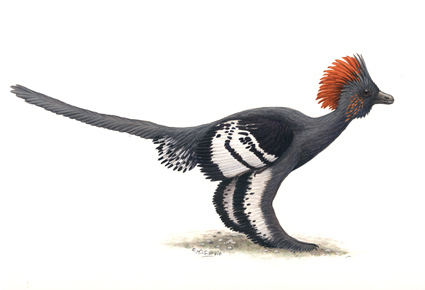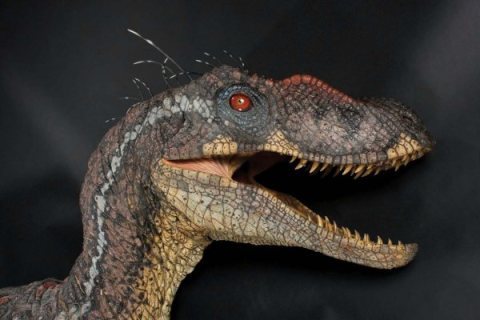Jurassic Park and the Fear of Feathers

Anchiornis huxleyi in full feather (Illustration: Michael DiGiorgio)
The much-delayed Jurassic Park 4 sequel was delayed again early this week, and it’s tempting to imagine that animal science might be the reason. (Okay, tempting and really, really stupid, but indulge me for a bit.) This lucrative movie franchise dates back 20 years now, to 1993, which is like saying it started somewhere in the Cenozoic as far as our understanding of dinosaurs goes.
When the original Jurassic Park was still in its first theatrical run, paleontologists were already digging up what has since become a gaudy parade of fossils demonstrating that dinosaurs were in fact frequently tricked out with feathers, feather-like filaments, and even a three-inch-thick coating of “dino fuzz.”
Universal Pictures grudgingly acknowledged this new science when it released Jurassic Park III in 2001. Like an anxious parent in the Punk Rock era, it allowed Velociraptor to flaunt a miserable little mohawk of about a dozen filaments sprouting out of the top of its head.
But otherwise the franchise has conformed to the stereotype of dinosaurs as scaly, naked red-eyed monsters. And for an obvious reason: A Tyrannosaurus rex that looked like Big Bird might not have audiences wetting their pants in the balcony, or opening their wallets at the box office. So back in March, Colin Trevorrow, tapped as the latest director in the series, tweeted: “No feathers. #JP4”
But maybe now he’s gone back for a re-think.

A Hollywood velociraptor
Here’s where the fossil evidence currently stands, as outlined by Julia Clarke, a University of Texas paleontologist who is also the author of an article “Feathers Before Flight,” appearing today, May 9, in the journal Science: Paleontologists have been thinking about the connection between dinosaurs and living birds since the discovery of the fossil bird Archaeopteryx back in 1861, and especially since 1970, when John Ostrom at Yale University pointed out the many similarities between bird skeletons and those of the Theropoda dinosaurs, including T. rex and Velociraptor.
The current revolution began in the mid-1990s, when … to read the full article click here.





